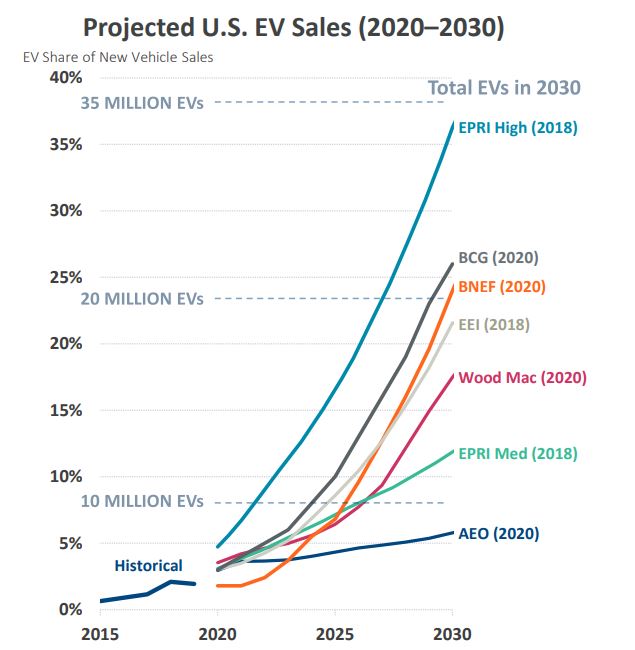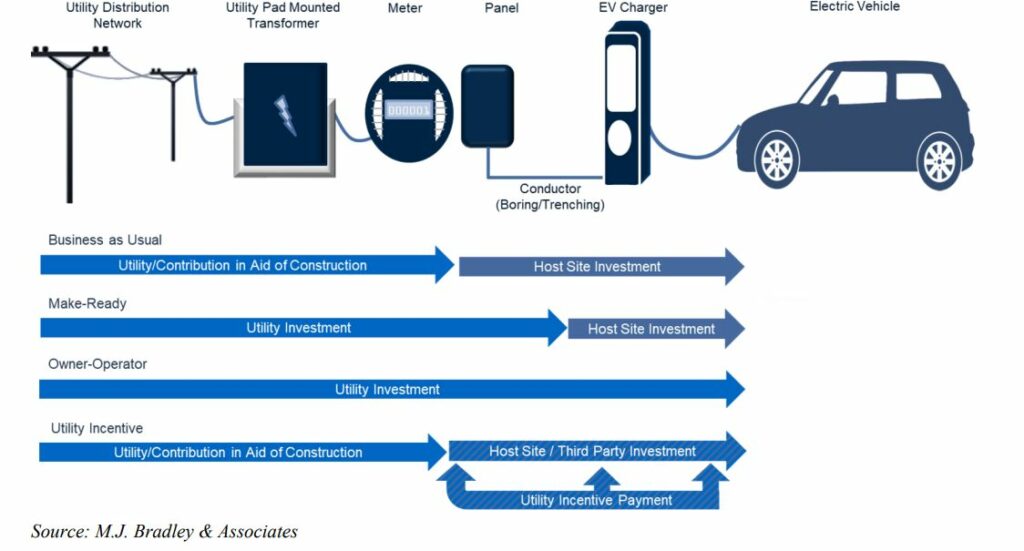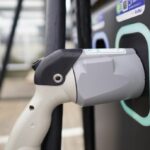Rise of EV- How we Got here
Since the introduction of the Tesla Roadster in 2008, electric vehicles have been rapidly evolving and being introduced into the public consciousness. The original Roadster offered a cruising range of 240 miles, a 0-60 mph time of 3.9 seconds, and a top speed of 125 mph for a price tag of $109,000, a hefty amount for a vehicle that was only capable of seating two people. However, the EV market has grown significantly since then.
According to Bloomberg New Energy Finance (BNEF) electric vehicles (EVs) are expected to be 35% of all new car sales by 2040 and could make up 54% of all cars on the road. This growth is driven by a number of factors including the desire for environmentally friendly transportation, the desire to reduce our dependence on foreign oil, and improved technology which has increased vehicle range and charging times. But as more and more EVs hit the road, we might find that our current infrastructure can’t support the demand created by all these vehicles.

As more consumers turn to electric vehicles, utilities have been taking notice and planning for their integration into the grid. Utilities are concerned about how charging EVs might impact the existing system and how they can ensure that there is enough power capacity available when needed. They are also concerned about peak demand events like hot days or snow storms days.
Electric Vehicle Impact on the Grid
EV charging will have a major impact on the grid. As more EVs go into service, peak demand problems increase as they charge while utilities also face the challenge of meeting load demands during the day.
While many experts differ on the extent EVs impact the grid and are primarily based on the assumption of rapid scaling of renewable by 2030 and 2050 which will compensate for additional demand.
One point where all experts will agree is the fact that while demand may be met by new renewable /DER, but this load adds enough stress on existing distribution infra if too many EVs are charging at once. For the same reason, Utility may choose to build new power lines near neighborhoods with high EV usage.
This allows for more efficient use of existing power lines and reduces the risk of overloading any one circuit. This rapid growth will require utilities to consider both peak demand and load growth in their long-term plans.
The timing of charging will have implications for generation capacity requirements as well as distribution resource needs. Rate design and rate case implications are also important considerations that utilities should be thinking about now.
Utilities Should Treat EVs as an Opportunity For Load Growth and Additional Revenue
Let’s put it this way: Electric utilities can turn this potential problem into an opportunity to grow loads and increase revenues. If you can manage the charging of electric vehicles, you can use them to smooth out load, reduce peak demand, use them for storage, and even potentially leverage them in demand response.
According to a study by brattle group, The adoption of plug-in electric vehicles (EVs) adds a significant new load to the electric grid. In the United States, it is estimated that 20 million EVs will add 60–95 TWh of annual demand and 10–20 GW of peak load to the system and require 12–18 GW of renewable capacity and 1–2 million public chargers to serve EV demand.
This can be translated as an increase in electricity sales would boost utility revenues by 2% to 5% per year.
Utilities need to have an EV Plan Now!
As the saying goes, you can’t manage what you can’t measure, and it is true in the context of EV growth. Utilities must understand the impact of EVs on their distribution system and customer base. This requires having a plan to support the charging infrastructure, electric load, and customer satisfaction.
As starting plan on how to respond to an increasing number of EVs in your service territory, here are 5 things Utility should consider as the first step
- Identify geography where utilities are seeing more EVs are being plugged into the distribution network, start with a heat map
- Understand the electric load from EV charging at different times of day
- Start looking at their bill rates and adders
- Look and analyze IVRs, Mailers, campaign responses across touchpoints
- Develop EV-specific rate offerings for utilities that have time-of-use rates
How Utilities Can Minimize, Grid Impact of Large Scale EV Adoption
1. Upgrade Infra, Get ADMS, DERMS in Place- Sooner The Better
One of the main reasons Utilities and experts see EVs may have an impact on the grid is because of the fact that EVs charge at a high voltage and draw a large amount of power.
This presents a challenge to the current infrastructure as it cannot supply the needed amperage to charge EVs in large quantities. Utilities need to upgrade their infrastructure to meet the demand for EV charging stations.
One potential solution is utilities need to have real-time data about when and where consumers are charging their cars. This would allow them to better predict EV usage and make necessary changes accordingly.
However, in order for this to work, utilities need access to advanced distribution management systems (ADMS) and distributed energy resource management systems (DERMS). These systems give utilities a clear picture of which facilities need upgrades in order for them to accommodate EV charging stations without causing issues with other parts of the electric grid.
Another big challenge is that if Utilities don’t upgrade their infrastructure now or implement ADMS or DERMS, they could experience an overload that causes blackouts and damage to sensitive equipment like transformers.
In short: as we see more influx of EVs, Utilities need to upgrade their infrastructure. The benefits of implementing EMS technologies far outweigh the potential negative consequences that could come from not doing so.
2. Treat EVs as a Demand Response & DER Resource as more V2G and V2V capable EVs hit the Road
This is not just a theoretical exercise. Some utilities are already using smart charging to manage demand, and others are considering the possibility.
For example, a handful of community choice aggregators, or CCAs – local public agencies that buy power on behalf of their communities in place of investor-owned utilities – have programs that encourage EV owners to enroll in demand response programs.
Once enrolled, they can earn rewards by agreeing to charge their vehicles during non-peak hours. Marin Clean Energy’s Charge Smart program, for example, offers $25 prepaid Visa cards per vehicle per year to customers who allow the utility to automatically delay their charging by four hours when they plug in between 5 p.m. and 10 p.m. or reduce their charging speed by 50% at those times if the load exceeds 100MW.
3. Encourage Customers to charge their vehicles at home when prices are low – Introduce Tailored, Personalized EV Rates
Utilities Should Allow Consumers To Charge Their Vehicles At Home When Prices Are Low. This can be achieved by Rate structures that encourage charging at off-peak hours will be key ingredients to mitigate the impact on the grid,” RMI writes in “Electrifying Efficiency: The Automotive Industry’s Race to Reduce Drag.”
Utilities can get the most from EVs by encouraging consumers to charge their vehicles at home when prices are low.
Currently, most mass-market EVs on the road only offer customers a way to charge at home, not at work or other locations. By encouraging consumers to charge their electric vehicles at home, utilities will be able to maximize their investments while maximizing customer satisfaction and convenience.
4. Start Leveraging the Power of AI and Advance Analytics
To manage this transition, utilities must use analytics to support EV penetration. Analytics can help with load forecasting, demand response, and customer engagement. When done correctly, it will be beneficial for everyone involved in the transition of electric vehicles becoming mainstream.
Utilities can also use analytics to support EV penetration. In addition to promotional campaigns, utilities should consider conducting an analysis of residential customer usage patterns.
By understanding a customer’s normal usage patterns and routine, a utility can help the customer identify what time of day he or she is most likely to charge their car.
Some may decide on charging at night while others may decide on charging in the middle of the day when rates are cheaper e.g., via time-of-use (TOU) rates in California or off-peak charging incentives like in Ontario where customers receive $0.10/kWh for using off-peak energy from 10 P.M.-7 A.M on weekends and weekdays.
5. Set up Task Force, Run Pilot Program
- Establish an EV task force with internal representatives from different departments as well as external stakeholders such as OEMs, dealerships, charging service providers, and local government agencies.
- Develop pilot programs or incentives for both consumers and businesses that focus on increasing EV adoption
- Conduct outreach and education campaigns to increase awareness of EV benefits among customers, especially in low-income communities
- Educate utility sales teams (internal/external) on EV market trends, benefits of EVs, how EVs interact with the electricity grid, how to sell EVs and charging services to businesses, etc.
- Create a business plan for providing charging services to customers (both residential and commercial)
New Business Model for Utilities in the EV Era
Utility and EV companies are working together to develop the EV value stack.
With the rise of electric vehicles, utilities and EV companies are working together to develop the EV value stack.
The rise of electric vehicles (EVs) is a huge opportunity for utilities. Utilities can play an important role in the transition to EVs by enabling convenient, cost-effective charging options for their customers. There are three business models that utilities can adopt:

1. Self-operation
This model involves utility building, owning and operating charging infrastructure, and charging services. This is the simplest model and gives utilities full control over the charging experience, but it requires a significant upfront investment.
2. Partnership
This model involves utilities partnering with third parties to provide charging as a service. With this model, utilities don’t have to make large capital investments upfront, but they lose control over the customer experience and may need to pay for access to real-time data from the chargers.
3. Coordination
This model does not involve direct investment or participation in charger deployment or ownership, but rather focuses on improving utility operations and planning to better accommodate EV charging on their system.
Final Thought
Finally, I would like to leave you with a few thoughts:
- The rise of Electric Vehicles is a fact. There are some uncertainties on the speed and scale of adoption, but the direction is clear.
- Utilities have a great opportunity to play a key role in the EV journey as it has all the ingredients to re-imagine its business model and redefine its relationship with customers.
- Utilities need to start preparing now by developing capabilities that will enable them to provide EV services to customers and make sure they can participate in this new market.

Anand is a seasoned utility consultant with more than 10 years of experience in the energy and utility domain. He has worked across the utility value chain. He specializes in Transmission and Distribution, Energy Retail, AMI, MDMS, Analytics, OMS, ADMS Implementation, and Cloud (AWS) areas.


